
William Henry Pratt, known professionally as Boris Karloff and occasionally billed as Karloff the Uncanny, was an English actor. His portrayal of Frankenstein's monster in the horror film Frankenstein (1931) established him as a horror icon, and he reprised the role for the sequels Bride of Frankenstein (1935) and Son of Frankenstein (1939). He also appeared as Imhotep in The Mummy (1932), and voiced the Grinch in, as well as narrating, the animated television special of Dr. Seuss' How the Grinch Stole Christmas! (1966), which won him a Grammy Award.

Abbott and Costello Meet Frankenstein is a 1948 American horror comedy film directed by Charles Barton. The film features Count Dracula who has become partners with Dr. Sandra Mornay, as Dracula requires a "simple, pliable" brain to reactivate Frankenstein's monster. Dracula discovers that the "ideal" brain belongs to Wilbur Grey who is wooed by Mornay to the operating table, despite the warnings of Lawrence Talbot.
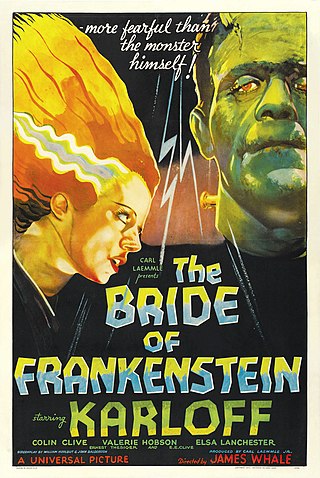
Bride of Frankenstein is a 1935 American science fiction horror film, and the first sequel to Universal Pictures' 1931 film Frankenstein. As with the first film, Bride of Frankenstein was directed by James Whale starring Boris Karloff as the Monster and Colin Clive as Dr. Frankenstein. The sequel features Elsa Lanchester in the dual role of Mary Shelley and the bride. Colin Clive reprises his role as Henry Frankenstein, and Ernest Thesiger plays the role of Doctor Septimus Pretorius. Oliver Peters Heggie plays the role of the old blind hermit.
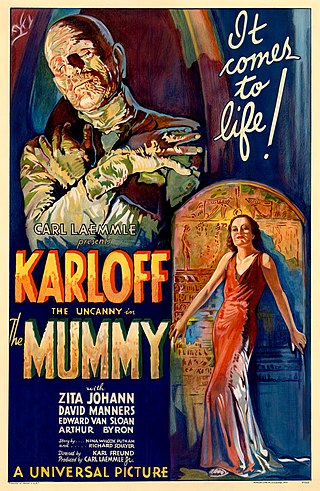
The Mummy is a 1932 American pre-Code supernatural horror film directed by Karl Freund. The screenplay by John L. Balderston was adapted from a treatment written by Nina Wilcox Putnam and Richard Schayer. Released by Universal Studios as a part of the Universal Classic Monsters franchise, the film stars Boris Karloff, Zita Johann, David Manners, Edward Van Sloan and Arthur Byron.

The Mask of Fu Manchu is a 1932 American pre-Code film directed by Charles Brabin. Written by Irene Kuhn, Edgar Allan Woolf and John Willard, it was based on the 1932 novel of the same name by Sax Rohmer. The film, featuring Boris Karloff as Fu Manchu and Myrna Loy as his daughter, revolves around Fu Manchu's quest for the golden sword and mask of Genghis Khan. Lewis Stone played his nemesis.

Dwight Iliff Frye was an American character actor of stage and screen. He is best known for his portrayals of neurotic, murderous villains in several classic Universal horror films, such as Renfield in Dracula (1931) and Fritz in Frankenstein (1931).
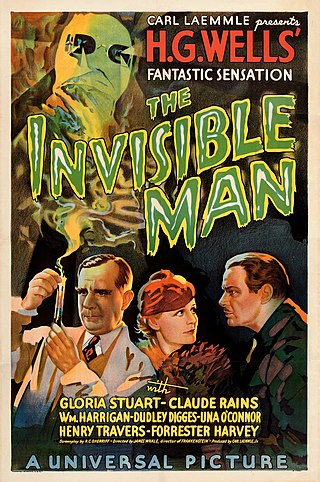
The Invisible Man is a 1933 American science fiction horror film directed by James Whale based on H. G. Wells' 1897 novel, The Invisible Man, produced by Universal Pictures, and starring Gloria Stuart, Claude Rains and William Harrigan. The film involves a Dr. Jack Griffin (Rains) who is covered in bandages and has his eyes obscured by dark glasses, the result of a secret experiment that makes him invisible, taking lodging in the village of Iping. Never leaving his quarters, the stranger demands that the staff leave him completely alone until his landlady and the villagers discover he is invisible. Griffin goes to the house of his colleague, Dr. Kemp and tells him of his plans to create a reign of terror. His fiancée Flora Cranley, the daughter of his employer Dr. Cranley, soon learn that Griffin's discovery has driven him insane, leading him to prove his superiority over other people by performing harmless pranks at first and eventually turning to murder.

The Black Cat is a 1934 American pre-Code horror film directed by Edgar G. Ulmer and starring Boris Karloff and Béla Lugosi. It was Universal Pictures' biggest box office hit of the year, and was the first of eight films to feature both Karloff and Lugosi. In 1941, Lugosi appeared in a comedy horror mystery film with the same title, which was also named after and ostensibly "suggested by" Edgar Allan Poe's short story.
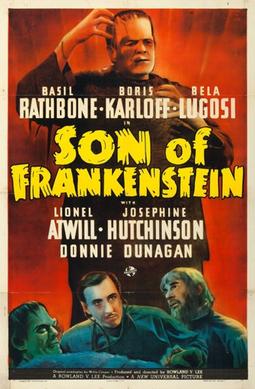
Son of Frankenstein is a 1939 American horror film directed by Rowland V. Lee and starring Basil Rathbone, Boris Karloff and Bela Lugosi. The film is the third in Universal Pictures' Frankenstein series and is the follow-up to the 1935 film Bride of Frankenstein. Son of Frankenstein stars Rathbone as Baron Wolf von Frankenstein who, with his wife Elsa and son Peter, returns to his late father's estate. Near the castle lives Ygor, a crazed blacksmith whose neck was broken in an unsuccessful hanging attempt. Among the castle's remains, Frankenstein discovers the remains of the Monster and decides to try to save his family name by resurrecting the creature to prove his father was correct. He finds, however, the Monster only responds to Ygor's commands.

Boris Karloff (1887-1969) was an English actor. He became known for his role as Frankenstein's monster in the 1931 Frankenstein, leading to a long career in film, radio, and television.

Black Friday is a 1940 American science fiction horror film starring Boris Karloff and Bela Lugosi.

The Invisible Ray is a 1936 American science-fiction horror film directed by Lambert Hillyer. It stars Boris Karloff as Dr. Janos Rukh, a scientist who comes in contact with a meteorite composed of an element known as "Radium X". After exposure to its rays begins to make him glow in the dark, his touch becomes deadly, and he begins to be slowly driven mad. Alongside Karloff, the film's cast includes Bela Lugosi, Frances Drake, Frank Lawton, Walter Kingsford, Beulah Bondi, Violet Kemble Cooper, and Nydia Westman.

The Body Snatcher is a 1945 American horror film directed by Robert Wise, based on the 1884 short story of the same name by Robert Louis Stevenson. Philip MacDonald adapted the story for the screen, and producer Val Lewton, credited as "Carlos Keith", modified MacDonald's screenplay. The film stars Boris Karloff as John Gray, a cab driver who moonlights as a grave robber, and later murderer, to illegally supply Dr. MacFarlane with cadavers for his classes, and makes mention of Burke, Hare, and Dr. Knox, in reference to the West Port murders of 1828. Alongside Karloff and Daniell, the film's cast includes Russell Wade, Edith Atwater, and Bela Lugosi. It was the last film in which both Karloff and Lugosi appeared.

House of Frankenstein is a 1944 American horror film starring Boris Karloff, Lon Chaney Jr. and John Carradine. Based on a story by Curt Siodmak, it was directed by Erle C. Kenton and produced by Universal Pictures. Based on Curt Siodmak's story The Devil's Brood, the film is about Dr. Gustav Niemann, who escapes from prison and promises to create a new body for his assistant Daniel. Over the course of the film, they encounter Count Dracula, Larry Talbot, the Wolf Man, and Frankenstein's Monster.

House of Dracula is a 1945 American horror film released and distributed by Universal Pictures. Directed by Erle C. Kenton, the film features several Universal Horror properties meeting as they had done in the 1944 film House of Frankenstein. The film is set at the castle home of Dr. Franz Edelmann, who is visited first by Count Dracula and later by Larry Talbot, the Wolf Man, who are trying to cure their vampirism and lycanthropy, respectively. Talbot is eventually cured, which leads him to discover the body of Frankenstein's monster in a cave below the base of the castle. Edelemann takes the monster's body back to his laboratory but finds Count Dracula has awakened and by attacking his assistants, he captures Edelmann and forces a reverse blood transfusion, which gives Edelmann a split personality and makes him a killer.
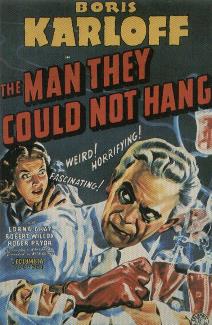
The Man They Could Not Hang is a 1939 American horror film directed by Nick Grinde from a screenplay by Karl Brown. It stars Boris Karloff as Dr. Henryk Savaard, a scientist who develops a procedure for bringing the dead back to life. When he is arrested and sentenced to be executed for murdering a young medical student who volunteered to be killed to test the procedure, Savaard vows retribution on the individuals responsible. Alongside Karloff, the film's cast includes Lorna Gray, Robert Wilcox, and Roger Pryor.
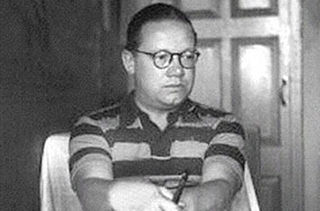
Garrett Elsden Fort was an American short story writer, playwright, and Hollywood screenwriter. He is mostly known for his connections with 1930s horror films, with film historian Gary Don Rhodes describing him as "one of, if not the pre-eminent horror film screenwriters of the classic era." He was a close follower of Meher Baba, and travelled to India while developing a screenplay based on Baba's philosophy.

Man-Made Monster is a 1941 American science-fiction horror film directed by George Waggner and produced by Jack Bernhard for Universal Pictures. Filmed in black-and-white, it stars Lon Chaney Jr. and Lionel Atwill. Man-Made Monster was re-released under various titles including Electric Man and The Mysterious Dr. R. Realart Pictures re-released the film in 1953 under the title The Atomic Monster as a double feature with The Flying Saucer (1950). On the film's original main title, there is no hyphen; it's simply Man Made Monster.

Frankenstein is a film series of horror films from Universal Pictures based on the play version by Peggy Webling and the 1818 novel Frankenstein; or, The Modern Prometheus by Mary Shelley. The series follow the story of a monster created by Henry Frankenstein who is made from body parts of corpses and brought back to life. The rest of the series generally follows the monster continuously being revived and eventually focuses on a series of cross overs with other Universal horror film characters such as The Wolf Man. The series consists of the following films: Frankenstein (1931), Bride of Frankenstein (1935), Son of Frankenstein (1939), The Ghost of Frankenstein (1942), Frankenstein Meets the Wolf Man (1943), House of Frankenstein (1944), House of Dracula (1945) and Abbott and Costello Meet Frankenstein (1948).




















